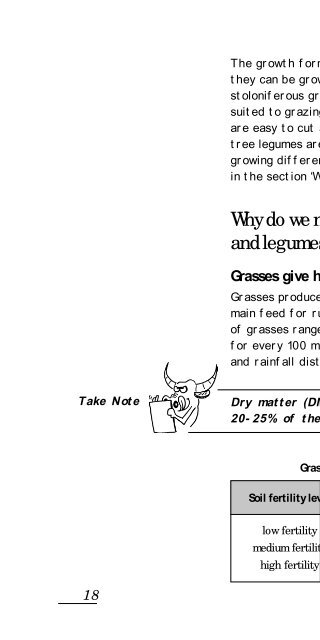Planting from vegetative material - cgiar
Planting from vegetative material - cgiar
Planting from vegetative material - cgiar
Create successful ePaper yourself
Turn your PDF publications into a flip-book with our unique Google optimized e-Paper software.
Take Note<br />
18<br />
The growth form and life span of forages affects how<br />
they can be grown and used on farms. For example, short<br />
stoloniferous grasses and legumes are particularly well<br />
suited to grazing and erosion control. Tall, upright grasses<br />
are easy to cut and can be grown in hedgerows. Long-lived<br />
tree legumes are ideal for living fences. The ways of<br />
growing different types of forages on farms are described<br />
in the section ‘Where can forages be grown on farms’.<br />
Why do we need both grasses<br />
and legumes?<br />
Grasses give higher yields<br />
Grasses produce more biomass than legumes and are the<br />
main feed for ruminant livestock (see Table below). Yields<br />
of grasses range <strong>from</strong> 400 – 2,000 kg of fresh, green feed<br />
for every 100 m 2 per year depending mainly on soil fertility<br />
and rainfall distribution.<br />
Dry matter (DM) yields of forage are approximately<br />
20-25% of the fresh, green feed.<br />
Soil fertility level<br />
low fertility<br />
medium fertility<br />
high fertility<br />
Grasses give higher yields than legumes.<br />
Grasses<br />
Legumes<br />
(kg of green feed per 100 m 2 per year)<br />
200 – 400<br />
400 – 1000<br />
1000 – 2000<br />
100 – 200<br />
200 – 300<br />
300 – 600
















